












Zhongshan
At Zhongshan Station, convenience meets a bustling cityscape. e junction for the city’s red and green lines is home to a wide array of eateries, the underground Taipei City Mall and three above-ground shopping centers.
After grabbing lunch at one of the local cafes or roaming the malls, visitors can wander around the back-alley streets. From thrift shops to boutiques, there is something for everyone.
In the evening, musicians and dancers perform right outside of the station’s primary exit, showcasing their talents to onlookers. And just a few minutes’ walk away, people can take a break from the bustling streets to browse
booths selling treats and antiques that are set up in a small park area.
Zhongshan has Xinyi station’s shopping experience with a more local feel, making it one of the trendiest stations in Taipei.
Jiantan
Despite its unassuming name, Jiantan Station boasts a multitude of activities to choose from. e station itself is nothing special, but popular attractions like the Taipei Performing Arts Center and Shilin Night Market sit just outside.
Inside the Taipei Performing Arts Center, visitors can find art installations, performances
and restaurants to enjoy with family or friends. e building itself is an innovation in architecture, with a ball that hangs precariously out the side of the building.
A little further down the street, visitors can hike up the Jiantan Mountain Hiking Trail or visit historic buildings like e Grand Hotel and the National Martyrs’ Shrine. e location of Jiantan Station allows visitors to explore an assortment of both new and old Taiwanese city life, making it one of the most underrated MRT stations.
Taipei Main Station
Taipei Main Station is the heartbeat of the capital, and with four different railway lines
By Katrina Fu (‘24)
e Interscholastic Association of Southeast Asian Schools (IASAS) Music Convention will happen March 1 to 3. Delegates representing Taipei American School (TAS) will travel to Singapore American School (SAS). is year’s music convention stands out compared to previous years due to its unique plans. For the first time, students are preparing for three distinct components of the convention.
e first component involves crafting their own solo pieces, which are oftentimes accompanied by a piano. ese solos will be performed and adjudicated at the festival by expert musicians in their respective areas.
e next component focuses on engaging students in chamber ensembles. ese ensembles involve collaborative efforts as students play together within their specific domains. ese ensembles are in preparation for the third component: the festival ensemble, a collaborative project where students from all IASAS schools unite. During this festival ensemble, there will be a guest conductor guiding and conducting the students, fostering students’ teamwork and connections beyond their school community. “ e festival prioritizes collaboration and growth over competition, creating a unique and special experience for all participants,” Ms. Andersen said.
In addition, three students deserve recognition for their exceptional character. Despite focusing on their individual piano solos, these students are also actively preparing to accompany their peers during their performances, a testament to the supportive environment within the music team. “We have three piano students that really show great character in how much they give up for the people on the music team,” Ms. Andersen said.
Ultimately, for March’s IASAS convention, each student is expected to perform at least one solo and one ensemble piece, specifically a chamber ensemble piece. Depending on the ensemble type, vocal students may learn two pieces, while students participating in the large ensemble may tackle four to six pieces. is year’s convention is planned to be extensive, with lots of teamwork and learning, providing a rich experience for all involved.
spreading to all parts of the island, it’s hands down the best metro station. e structure of the station itself is iconic with its curved temple style roof, sitting over a food court with the best mochi in town. e station is a hub of transportation, housing two metro lines and rails from the local train to Kenting to the High Speed Rail to Taichung. e station also has an Airport Express allowing access to the airport in 45 mins by train.
Further from the station is Taipei’s only three star Michelin restaurant, Le Palais. Offering a wide selection of Taiwanese and Cantonese cuisine, this restaurant is one of the best on the island.


The English Departnment is just one of the many departments making credit changes.
By Erin Wu (‘25) & Annabelle Hsu (‘27)
e Upper School Administration is in the process of making decisions regarding credit and course changes to the Upper School curriculum for the next school year. Besides introducing new courses, these changes will also lead to specific adjustments concerning English 9 courses.
ere will be several new courses available next year, many of which are to expand the number of IB courses offered. Some of the new classes include Honors European History and Western Political ought, IBHL Economics, Honors Research in Data Science and Honors Painting.
Apart from adding even more variety to the course catalog, one major change going forward is merging the two English courses
for ninth graders—English 9 and Honors English 9-–into a singular class. As such, all incoming ninth graders will take English 9 in the years to come. “We want to ensure that we are being developmentally appropriate because not all students develop their skills at the same rate,” Mr. David Montgomery, the head of the English department, said. “If we can give them that additional year, we know that we will be making AP, IB and other Honors courses from grades 10 through 12 available to more students.”
Merging the Honors and nonHonors courses is possibly a decision that administrators will continue to make to humanities courses in the future, as a similar decision to make History of Asia a mandatory course for freshmen was
implemented last year. e same does not necessarily apply to math or science courses because computational skills are picked up at different speeds and are built upon each other, whereas the learning curve of English and history are distinctly different. “ e humanities courses can be a bit more forgiving by giving you a little more time to relearn a skill if you missed it previously,”
Ms. Becky Read, the Upper School principal, said.
Some parents have raised concerns about the lack of a grade-point average (GPA) boost that Honors courses provide for their children who may have considered taking Honors English 9. One way the English department has tried to mitigate this concern is to open up more Honors English electives.
“ ere are a total of two changes,” Mr. Montgomery said. “ ere won’t be a teacher recommendation required for Honors Creative Writing going forward, and we’re making Journalism an Honors course for all grade levels, though traditionally it has been non-Honors for first-year takers.”
Ultimately, though significant changes are being made, the Upper School Administration assures that these decisions have been made with the best interests of students in mind. “We’re looking at our curriculum and our teaching methods from an analytical perspective, trying to offer the absolute best quality instruction as possible,” Ms. Read said. “Curriculum is a living document. A good portion of our training is analyzing, writing, and changing the

By Katrina Fu (‘24)
Service learning is a dynamic educational approach that effectively connects schoolbased curriculum with the inherent empathy and concern young individuals have for their communities. is educational approach, grounded in research, seamlessly integrates classroom instruction with hands-on experiences aimed at addressing authentic community needs. It empowers youth to take proactive roles in serving their communities while providing structured opportunities for reflection on their service endeavors. Additionally, service learning serves as a platform for demonstrating acquired skills and knowledge in real-world contexts.
In the IB English Language and Literature course, a significant improvement has been made by incorporating a unit focused on a local film, “Panay,” addressing land
ownership among the indigenous Taiwanese Amis community. Last year, guest speaker, Mr. Toby Openshaw, shared insights into the history of indigenous peoples in Taiwan and his connections with various indigenous communities. e decision to expand service learning in this particular unit was influenced by its relevance, inspiring content and the opportunity to highlight marginalized voices, especially for students who have lived in Taiwan for most of their lives.
Another guest speaker, oy away maya, a member of the Saisiyat tribe, shared five specific challenges Indigenous people face in Taiwan. e English department held bracelet making workshops with two Ami teachers, Kamulang and Falahang. In the workshop, students were taught how to make bracelets as well as being taught their traditional significance. en, the IB students
collaborated with the Lowerschool on their Indigenous unit, teaching them how to make a simpler version of the Ami bracelet.
e service learning aspect of the unit is structured around four types: direct service, indirect service, advocacy awareness action and research. e primary focus for the new IBLAL service learning unit is to address two essential questions: How to honor local Indigenous communities as a school? And how to cultivate long-term positive relationships with them?
e expansion of this unit aims to provide students with more opportunities for service learning, creating a framework that magnifies the voices of marginalized communities. Additionally, collaborative efforts between different school divisions, such as the braceletmaking workshop with third graders, offer a chance for increased interaction across the
school. e improvements made to the course reflect a commitment to enhancing the overall learning experience and fostering positive engagement with local communities. As it should be in an international school, service learning proves to be an impactful educational method, connecting classroom curriculum with community involvement and nurturing empathy among youth. e broadened service learning opportunities within the IB English Language and Literature course exemplify a dedication to amplifying marginalized perspectives and fostering authentic connections with local communities. rough hands-on experiences and guest speakers, students not only gain valuable insights but also actively contribute to addressing real-world challenges. ese initiatives underscore a commitment to enriching the learning


By Aiden Shen (‘27)
Taylor Swift’s Eras Tour (which commenced on March 17, 2023 in Glendale, California and is set to conclude on December 8, 2024 in Vancouver, Canada) has grossed over $1 billion and taken the entire world by storm, teenage girls and middle-aged men alike. Each show spans over 3 hours, with a set list of 44 songs grouped into 10 distinct acts based on each of Swift’s iconic albums.
!e Taylor Swift concert in Tokyo, Japan was a centerpiece event of February 2024. !e Japan leg of Swift’s world tour lasted four days and took place in the Tokyo Dome. !e tickets for the concert sold out within 30 minutes of being released and was one of the fastest-selling concerts of 2023.
Taylor Swift is an icon of the music industry and has generated about 1.82 billion dollars from her music career. !e fan base, known as Swifties, are some of the liveliest fans in the world. !e dedication from some of these fans is incredible. Over the Lunar New Year break, many students and faculty ew to Japan from Taiwan to watch the concert.
“I was lucky enough to get tickets, and everyone else was trying to go. Not only is
Swift’s music fun and catchy, but I listened to her album “Fearless” a lot when I was younger, so it’s a small throwback/ tribute to that part of me,” Ms. Jei-Jei Tan, an Upper School English teacher, said. “!e show has such a high production value— with the sets, costumes, backup dancers, literal #re, Swift herself running from one end of the huge stage to another while singing live... It is truly impressive!”
“!e concert was nothing short of spectacular. I loved and enjoyed everything about the concert. !e series of songs was amazing and everything she does is amazing,” Samantha L. (‘27, she/ her), one of the students who attended Swift’s concert, said. “At one point, she even made eye contact with me, she was dazzling. Easily one of the best artists of this generation.”
“Easily one of the best artists of our generation.”
From her humble beginnings as a country singer-songwriter to becoming one of the most in uential #gures in pop

music, Swift’s evolution has been nothing short of remarkable. Having endured endless misognyny in the music industry, multiple lawsuits, and even losing the ownership rights of her #rst 6 albums to the hands of American entreprenuer Scooter Braun, Taylor Swift remains an unstoppable force in the music industry. With her captivating storytelling, infectious melodies, and unwavering authenticity, she has left a sizable mark on the world of music and inspired generations of artists to follow in her footsteps.
However, Taylor Swift’s immense impact isn’t just in the music industry, she has had a lasting impact on women around the world.
“Taylor Swift is known for her enchanting performances, especially now with the Eras Tour. Her energy with the crowds is infatuating and makes everyone never want to leave,” Luvina C. (’27, she/ her), a selfproclaimed Swiftie, said. “Her songs vary in many genres, but behind those songs, she writes about relatable topics which is why she is such an icon.”
With each new chapter of her massively impressive and creative career, one thing is certain: the best of Taylor Swift is yet to come.
Across:
4. Which artist did several TAS students y to Japan to see?
5. Who is the author of (arguably TikTok’s most well-known yet controversial #Booktok book?
7. Who is the star of the new #lm Wonka?
9. Who is the eponymous main character of So#a Coppola’s newest #lm?
10. What is the name of a highly popular sushi chain in Taiwan?
Down:
1. Which football team won the Super Bowl this year?
2. Which IASAS sport did TAS host for this year?
3. Who performed at the Super Bowl halftime show this year?
6. Which cosmetic store has recently been in#ltrated by 10-year-olds?
8. Which social media app rose to newfound popularity within the past 5 years?

800 ZHONGSHAN N. RD. TAIPEI 11152 TAIWAN
EDITORIAL BOARD
EDITORS-IN-CHIEF
VICTORIA HSU (‘24)
ABBY CHANG (‘24)
MANAGING EDITOR (PRINT) KATHERINE MA (‘24)
MANAGING EDITOR (ONLINE) ERIN WU (‘25)
STAFF WRITERS
KATRINA FU (‘24)
SOFIA VALADAO (‘26)
AIDEN SHEN (‘27) ANNABELLE HSU (‘27)
ADVISER
MR. PATRICK YOUNG
MISSION STATEMENT
The Blue & Gold is a student-run publication dedicated to sharing stories from the Taipei American School community. Regularly publishing content by student reporters during the academic year, The Blue & Gold strives to inform our school community by covering events and issues relevant to TAS and showcasing the diversity of our community.
CORRECTIONS
We take all measures possible to report accurately and seek to bring professional, thorough reporting to our readers. Please report any inaccuracies in our content to our email, blueandgold@students.tas.tw.
OP-EDS AND EDITORIALS
Editorials collectively represent the opinions of The Blue & Gold’s editorial board, while op-eds represent the opinions of each writer. Opinions in The Blue & Gold do not necessarily re ect the views of the TAS student body, sta , faculty or administration.
LETTERS TO THE EDITOR
We welcome letter submissions from all readers. Email your signed letter of under 500 words to blueandgold@ students.tas.tw.

TAS community welcomes basketball athletes from IASAS schools for a successful tournament




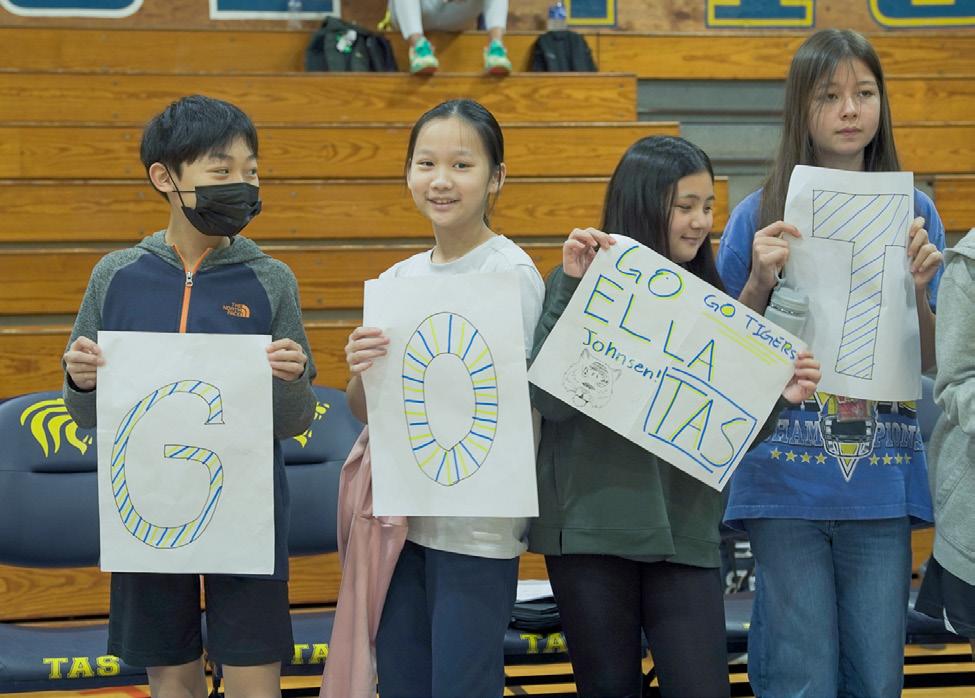

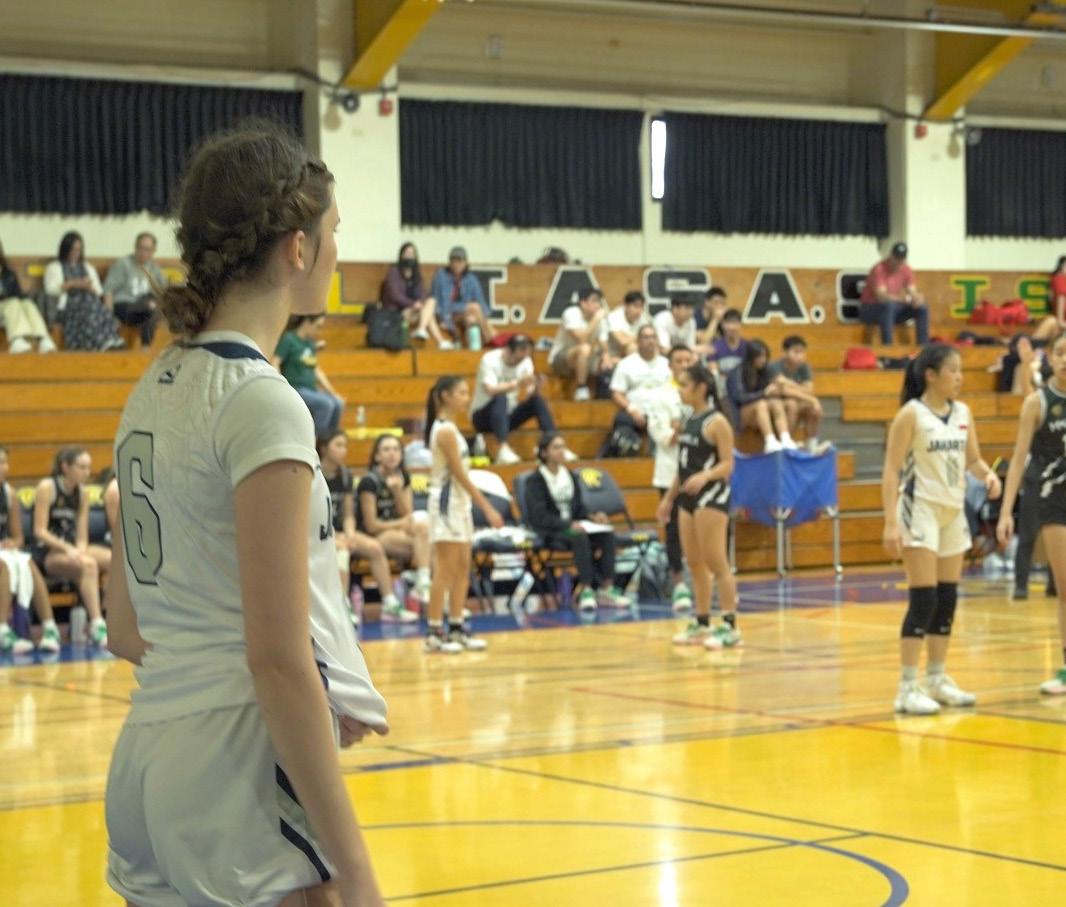
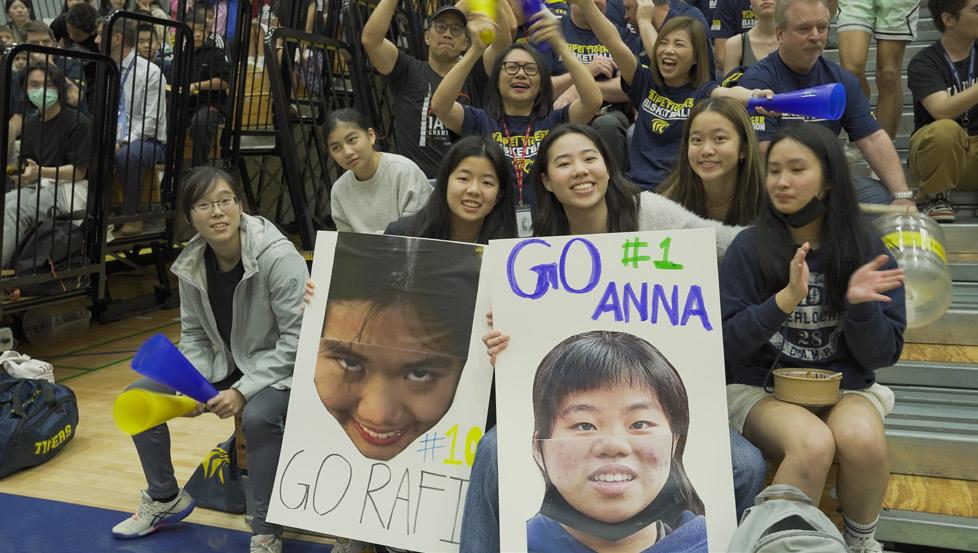



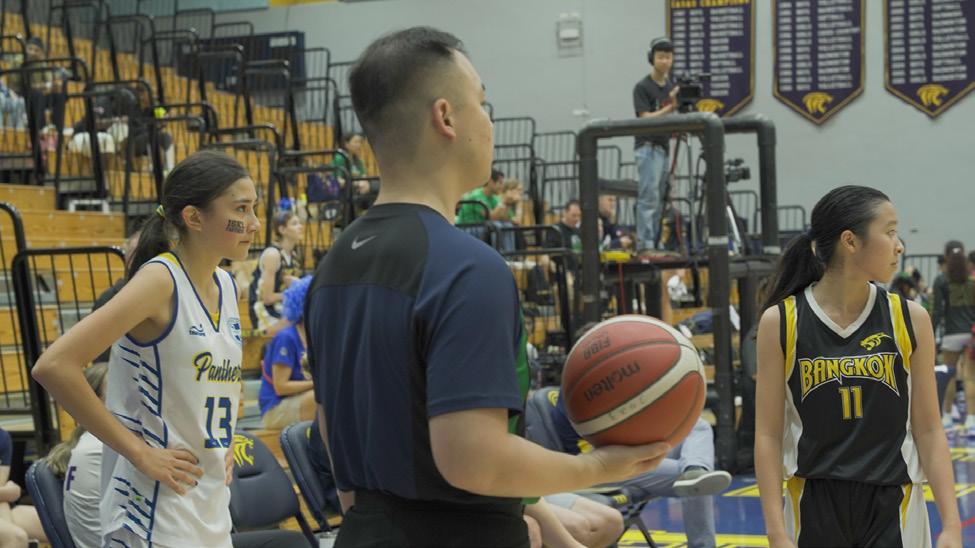



By Victoria Hsu (‘24) & Sonja Hammond (‘26)
Taipei American School (TAS) athletes returned after another successful Interscholastic Association of Southeast Asian Schools (IASAS) sports competition. This season, every team returned with a medal. The touch and rugby teams traveled to International School of Manila (ISM), the tennis athletes traveled to International School of Bangkok (ISB) and the swimming team traveled to Jakarta Intercultural School (JIS). TAS hosted IASAS athletes from the other ve schools for the rst home IASAS in four years.


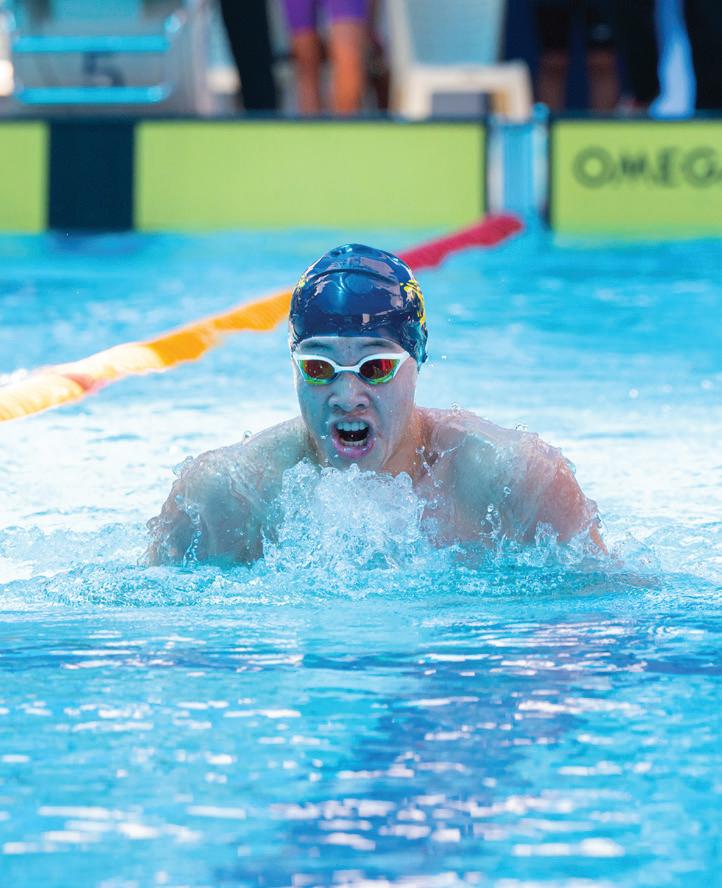
The boys’ rugby team took silver after a close match against SAS. A highlight of the season was a 56-0 shutout against ISKL. Ethan T. (‘25) captained this year’s team.
Despite end result, he is hopeful for next year. “[I’m] obviously disappointed with the outcome but proud of what the rugby boys were able to achieve,” Ethan said. “I think there is definitely a good group of boys coming up.”
He urges other members in the TAS community to come tryout next year, “If you’ve never played rugby before, get down to the field and try something new. It’s super fun and you won’t regret it.” Ethan said.

The boys tennis team placed rst, winning their nal match against ISB. is year, the team was led by captains Joaquin H. (‘24) and Juan B. (‘24)
After 14 years, the boys tennis team was able to secure gold for TAS. “We felt like we had a really strong team and gold in sight, but we knew it wouldn’t be easy,” Juan said. “It felt like all our training in and out of school paid o and I’m thankful for that.”
Juan is con dent that his team is prepared for next year. “ ere are lots of strong candidates to ll up my singles spot, and I see no reason why the team won’t get gold again,” he said. “I wish Joaquin could have been here to win gold with us. I wish he could have been part of that unbelievable moment when we swept ISB in the nals and ran onto the courts screaming.”

The boys swimming team placed second against SAS. Led by captains Brian W. (‘24), Douglas C. (‘24) and Sean H. (‘24), the swimming team fell slightly short of bringing the championship plaque back to TAS.
Going into IASAS, Douglas was con dent his team would be performing to the best of their abilities. “ e team was looking strong and I could tell everyone wanted to win.” he said.
Even though the team did not do as well as they had hoped, Douglas is still proud of how they all performed during the tournament. “We did the best we could as a team,” Douglas said. “I trust that Ethan and Sebastian will do wonders for the team next year.”

The girls touch team placed second with a remarkable 0 losses before a defeat in the nal against ISM.
“I was a bit nervous going into IASAS, but I was so excited to see how our team would perform and I knew we would have a lot of fun,” Ava T. (‘24), the captain of the touch team, said. She is very happy with all her team has accomplished this year. “I am so proud of our girls. e team exceeded my expectations and I am so proud of our outcome,” she said.
Even though she is leaving the TAS touch program this year, she is sure her team is well prepared for IASAS next year. “Be patient and trust the process,” Ava said. “I am con dent [we] will do great.”
The girls tennis team nished second in the tournament. Captain Karina C. (‘24) was disappointed to see ISB take gold.
“It has been a while since girl’s tennis entered the nal, and this year’s team was the rst one to do it in a couple of years,” Karina said. “We de nitely had it in the beginning, but I think the home crowd got us at the end.”
Even with the disappoointing outcome, Karina is still extremely proud of her team. “I think that we have grown so much from IASAS,” she said. “ ere were some members of the team that needed the tournament experience to strengthen their mindset. I believe they will use the loss in the nals to prepare for next year.”
The girls swimming team placed third. The team, led by captains Charlotte W. (‘24), Cindy L. (‘25) and Isabelle L. (‘25), fell slightly behind SAS in points. However, the girls relay team set a new record at IASAS for the 4x100 free.
“I’m super proud of this team and how far we have come,” Charlotte said. “We have all trained and worked so hard this season, so seeing everyone try their best to get personal bests and points was all that mattered.”
Charlotte is confident her team is ready for IASAS next year. Being the only senior, she is sure her teammates will have enough experience to perform well. “Keep training hard, don’t hold back and give it your all every race,” she said.


By Victoria Hsu & Abby Chang (‘24)
Taipei American School (TAS) has nally hosted its rst sports Interscholastic Association of Southeast Asian Schools (IASAS) tournament, the IASAS Basketball Championships. e tournament lasted from Feb. 1 to 3, with athletes from Singapore American School (SAS), International School of Bangkok (ISB), International School of Manila (ISM), International School of Kuala Lumpur (ISKL) and Jakarta Intercultural School (JIS) arriving in Taipei on Jan. 31.
e tournament kicked o with intense round-robin games, ending with the championship games on Saturday.
e boys team, led by captain Aiden C. (‘24), placed second, losing in their nal match against ISM. “It’s easy to get caught up in all the negative emotions, but at the end of the day, we played for each other and we tried our best,” Aiden said.
e girls team, led by captains Sarah Y. (‘24) and Ella J. (‘24), placed rst in a close match against SAS. ey were able to keep the gold they had earned last year at ISM. Celia R. (‘25) broke the tie, scoring the nal basket, making the score 30-32 in the last 10 seconds of the game. “It felt surreal to win in the championship game especially since the score was so close,” Sarah said.
Behind the scenes, the athletics department, lm department and the Parent Teacher Association (PTA) boosters
worked tirelessly to ensure the athletes had an enjoyable IASAS experience.
Over the course of the three-day tournament, the PTA o ered food options for everyone. “From the PTA’s side, we have asked all the basketball parents to help bring in food for all the visiting families and athletes,” Ms. Katherine Chou, a parent booster of the PTA, said. Visiting thletes also had the option of cafeteria food, the Tiger Grill, food trucks and bento boxes.
To enhance the spectator experience and to get more students involved, Mr. Toby Openshaw, the video production specialist, o ered students across Upper School the opportunity to assist the lm department with live-streaming games in both the Derryl Franz Middle School Gymnasium (MSG) and Upper School Joie Gymnasium (USG). Prior to the tournament, student volunteers underwent practice sessions after school where they learned to manage video cutting and camera work to familiarize themselves with the technology. “It was really fun, especially learning how to use the camera and computer equipment,” Emma W. (‘26), a student volunteers, said.
Bringing in and uniting the TAS community was a big goal during the IASAS tournament. roughout the three days, the lower school, middle school and upper school communities ocked to the gyms in support of the basketball teams. A particularly wholesome act came from the

lower school students who created many posters and banners to cheer for the TAS teams. However, their enthusiasm extended beyond just TAS. When TAS teams were not on the court, the lower school students cheered for other IASAS schools. “We want the community involved,” Coach Kawamoto, the athletic director, said. “Hopefully we have passion, not just for our games, but for all the teams.”
“Hopefully we have passion, not just for our games, but for all the teams.”
“I feel like the pinnacle of the IASAS experience is making friendships that exist beyond your school,” Alexa L. (‘24), a basketball player from SAS, said. “ e support that all the teams received from the TAS community made my IASAS experience so much better.”
e enthusiasm of the tournaments was further ampli ed by the spirited presence of parents. ey distributed cheering props like drums, leading to spirited chants and cheers in the stands. eir spirited contributions not only uplifted the morale of the players but also added an extra dimension of joy and excitement to the
tournament experience. “I felt that being at TAS, in front of a crowd, really gave everyone the con dence they needed to play their hardest,” Sarah said. “I loved hearing all the drums the parents brought to the game because it really hyped everyone up.” e performing arts community was also asked to participate in the IASAS tournament to ensure athletes had a unique experience. At the opening ceremony, Opus, the selective upper school choir, sang both the American and Taiwanese National Anthems to welcome the athletes to Taiwan, as per IASAS tradition. During the championship games on Saturday, Middle School and Upper School dancers performed during the halftime of the games. e Middle School dance group performed at the boys championship game while the Upper School dancers were invited to perform for the girls game. “We thought of doing something to promote spirit,” Ms. Cheryl Lagerquist, the upper school dance teacher, said.
e Student Government o cers and Athletic Coucil president were also asked to participate in welcoming IASAS athletes by speaking during the opening ceremony.
Within the three eventful days, from the dedicated e orts of various departments to the enthusiastic support of students, parents and the hardworking players, the IASAS basketball tournament exempli ed unity and spirit.


By Victoria H. (‘24)
Art is a universal language for self-expression. With this intrinsic need to create, comes a desire to share artworks with others. Although Taipei American School (TAS) holds many art showcases for students as part of the art program, students have also opted to host their own exhibitions. These aspiring artists were able to bring their art to life and share their collections with the public.




“Under the Bodhi Tree” by Bita S. (‘24) was an art exhibition hosted at a children’s home in Yilan County. rough her solo exhibition, Bita aimed to share her cultural heritage, as well as her connection to Buddhism, with her viewers. e exhibition was from Oct. 9. 2023 to Nov. 6, 2023. e pieces in the exhibition were mostly done with watercolor and a couple of them were painted with gouache, ink and oil pastels. Not only did the variety of mediums allow her to further explore her artistry, but the different mediums also added to the art experience itself. “In my watercolor pieces, the water allows the colors to flow into each other
and create a harmonious tone,” Bita said. e location of the exhibition, itself, held sentimental value to Bita. “I visited the home many times as a child, and the 師傅s (masters) there knew me and watched me grow up since I was a young kid,” Bita said. “I even had the opportunity to work with the children to create a big artwork together spanning an entire wall.”
Bita’s exhibition also included an interactive section for some of the children at the children’s home to participate in. ey worked together to create a giant mural on paper that reflected many of the themes displayed in Bita’s earlier works.
“Interstellar” was an art exhibition held by Ena H. (‘24) and her mother, Ms. Donna Huang. e exhibition explored the interactions between space and human lives. Her exhibition was set in a public mall, and lasted from Nov. 3, 2023 to Nov. 14, 2023.
e exhibition itself showcased numerous mediums, ranging from watercolor to 3D sculptures to software printouts. “When you enter the exhibit, it feels like there are 20 different artists,” Ena said. “We explored many different art styles and techniques for our exhibit.”
Ena believes that her exhibition served as a bonding experience for her and her
mother, especially as she prepares to depart for college later this year. “I think part of the exhibition showed how interests can pass through generations,” Ena said. “Even though both me and my mom come from the same environment, our work is super different.”
Despite spending many long and tiring hours standing around her work, Ena is extremely grateful for the support she received from friends, teachers and the public. “It’s really interesting to see how people perceive your work,” she said. “Since I’m still in high school, I’m still working on my own style and curating my own works.”
“ e Time When Dinos Invade Taiwan”, or “當恐龍入侵台灣”, was an exhibition held by Candice C. (‘24). One of the biggest themes that she explored was her cultural heritage through the motif of dinosaurs. e exhibition, which started on Oct. 7, 2023 and ended on Oct. 22, 2023, was held in a small cafe gallery.
Being one of the first of her fellow student artists to host an exhibition, Candice found it difficult to organize and set up her space. “ ere had to be a lot of communication between my art teacher, Mr. Morris, and our department head, Ms. Kao,” Candice said. Nonetheless, the smaller space provided a more intimate setting for Candice to
interact with guests. She was able to hear interpretations of her work from other people that were passing through. “After school, I was able to just sit there and enjoy watching strangers looking at my work,” Candice said. “My favorite part was how I got to meet many strangers and other artists and exchange ideas.”
She is grateful for all the support she recieved from her friends, family and the public.
Her favorite piece, titled “記憶中的罐 頭塔”or “Can Tower in My Memory”, was also selected to travel as a part of the IASAS Art Showcase at Jakarta Intercultural School (JIS).
“Hadal Zone - Light is the Revelation” was an exhibition hosted by Feronia L. (‘24) in a rented creative space at Songshan Cultural and Creative Park. from Aug. 1, 2023 to Aug. 9, 2023.
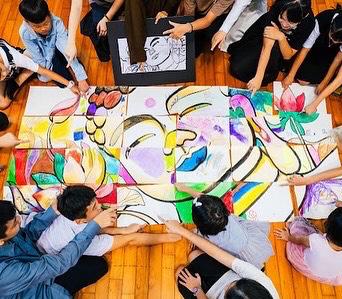


e art that she curated for the exhibition was a series of plaster sculptures and LED lights inspired by creatures of the sea. “I felt that if I didn’t give [my sculptures] a proper exhibition, they would probably never be properly represented,” Feronia said. Feronia utilized lighting and a darker background to manipulate the way viewers perceived her art. For Feronia, one of her biggest struggles was working with electricity. “Plaster is actually activated by water, but I’m working with electricity,” Feronia said. “I was trying not to damage the [electricity outlets], but something ended up going wrong and I was in a frenzy to fix it.”
Her favorite piece, titled “Rayven”, was also the first piece she created. “It really allowed me to develop my concept further,” she said. “Rayven” was constructed with cast and LED lights wrapped throughout. Ultimately, Feronia wanted to create a peaceful atmosphere for the audiences of the gallery through her manipulation of light.
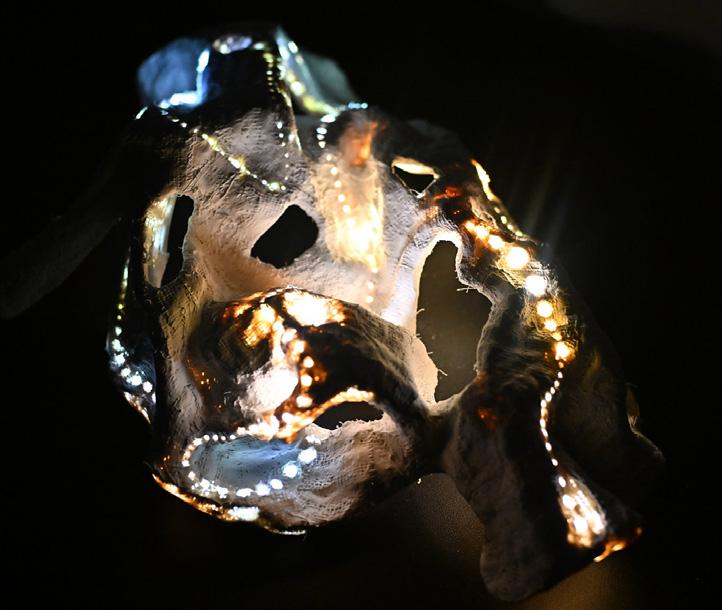

Entering an impressionist painting & celebrating 150 years of Van Gogh’s legacy

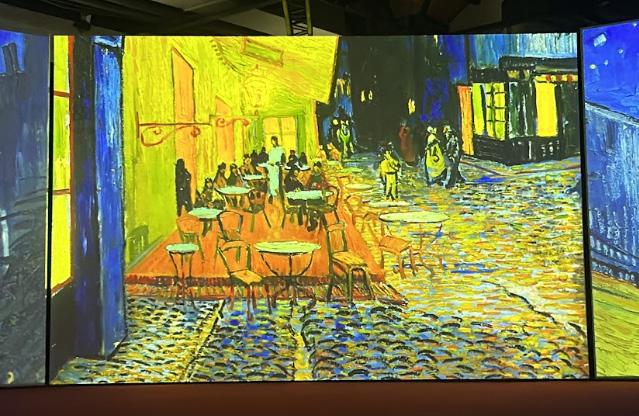




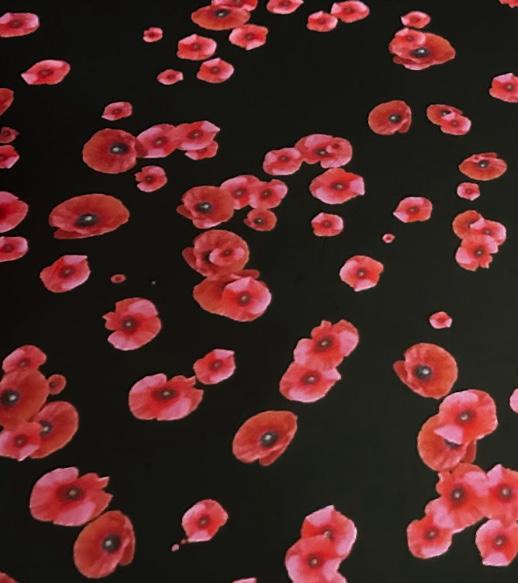
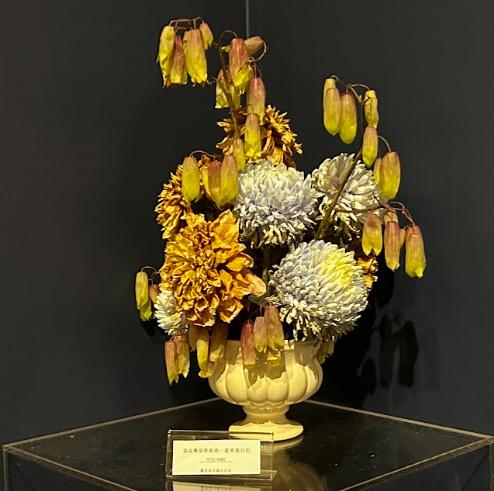


By Katherine Ma (‘24) and TAS].”
Taipei American School (TAS) anticipates the arrival of Mr. David Frankenberg (he/him) as the new Head of School for the 2024-2025 school year. Currently, Mr. Frankenberg is serving as the Head of School for Drew School in San Francisco, California. Originally from Argentina, Mr. Frankenberg grew up as a student at Hong Kong International School (HKIS)
It was during his time at HKIS that he first heard about TAS. “I’ve always respected and admired [TAS] so much,” he said. “I always had this dream in the back of my mind where I would go back and work with or lead a school like [HKIS
Mr. Frankenberg began his career in business consulting before becoming a teacher and entering the field of education. “I was kind of a difficult kid at school sometimes, so I never imagined I was going to become a teacher,” he said. “But then I started teaching and saw this ability to be able to impact kids in their transformative years, and I just found my calling.”
So far, Mr. Frankenberg has been working extensively with the Interim Head of School Ms. Evelyne Estey to help ease his transition to TAS. “She’s been amazing. I’m very glad that she’s there [at TAS]. I think she’s an extremely capable, thoughtful, and caring leader,” he said.
“I was most impressed about the seriousness of purpose in the people at TAS.”
As a part of his transition, Mr. Frankenberg visited Taiwan in January to meet school faculty, parents and administrators. “I was most impressed about the seriousness of purpose in the people at TAS. Everybody is very passionate about education—very passionate about what they do,” he said.
Besides his passion for education, Mr. Frankenberg is also a foodie and chef. Despite his packed schedule during his January visit, Mr. Frankenberg still made sure to make time to experience Taiwanese cuisine. “I remember sneaking out to the night market just to be able to try some authentic food, and it was amazing,” he said.
Mr. Frankenberg believes that learning about the community’s expectations and goals is an important first step as the head of school. During his time at TAS, Mr. Frankenberg looks forward to immersing himself in the school’s culture and values and learning more about the community.


By Katrina Fu (‘24) & So a Valadao (‘26)
Aaron C. (‘24, he/him) has been playing golf for over 10 years and has committed to play the sport competitively at Macalester College in Saint Paul, Minnesota. “ e rst time I picked up a golf club was when I was in second grade,” Aaron said. “My parents were hoping to nd an activity that I could do that [would] help [improve] my eyesight.”
has represented (Taipei American School) TAS four times at (Interscholastic Association of Schools in Southeast Asia) IASAS and was medaled for his outstanding performance in his sophomore and junior years. Outside
of the TAS varsity boys swimming team and plans to swim competitively at Brandeis University in Waltham, Massachusetts.
been a hobby of his, Douglas only started to take the sport more seriously after watching Michael Phelps’ inspirational victories at the 2016 Olympic Games.
of school, he also
competes at state-level tournaments in the United States. One such competition was the Northern California Players Championship where he won with a record score of 14 under. Additionally, he was placed in the top 15 category for the California State Championship.
Taking inspiration from golf legend Tiger Woods, Aaron channels a similar work
captain of TAS’ varsity boys baseball team and intends to play the sport competitively at Amherst College in Amherst, Massachusetts. Although he’s been playing baseball since elementary school, Matthew only truly discovered his passion for the sport in his freshman year of high school after breaking his foot.
problems and mistakes that have occurred, letting me have a [fresh] start.”
Aaron views playing golf at the collegiate level as an opportunity to further enhance his skills with top-notch facilities and improved time management. “I wanted to play better in the future so I decided to play college golf since it gives me time to practice and improve my game. I also enjoy the feeling of competition when I play which can be elevated to the next level in college golf where the opponents are tougher,” he said.

For students hoping to get recruited, Aaron advises them to start participating in tournaments around the US. “If you

think you have good scores, try to send them to coaches when you are in your sophomore or junior year so that they know to be aware of you and look for your progress,” he said.
“[After breaking it], I knew I wanted to play, but my skill level was not as good as some of my teammates. So I trained almost everyday in order to catch up to them and get a spot on the team,” Matthew said. “And now after 3 years, seeing how much I have progressed meant a lot to me.”
Despite his skill and experience, like
Brian W. (‘24, he/him) is the co-captain of TAS’ varsity boys swim team and is committed to swimming competitively at the University of Rochester in Rochester, New York. Despite only beginning to take swimming seriously in eighth grade, Brian has enjoyed participating in the sport leisurely since growing up as a child.
In particular, Brian takes great pride in the contributions that he has made to TAS’ IASAS swim team.
people say baseball is 90% a mental game, and that there will be times where nothing is working and that all the work you’ve put in is a waste,” Matthew said. “However, there will also be times when you’re on a streak and feel like you can’t be stopped. I think to overcome this game you can’t let one moment control you, you can’t get too disappointed in a bad game and you can’t get too laidback when you’re succeeding.”
To help maintain his dedication, Matthew tries his best to regularly set small and achievable goals while working to achieve a larger end goal of his.
“Baseball in general has taught me

During this winter’s IASAS swim competition, he won the boy’s 100 meter and 200 meter breastroke races, bringing
In addition to his accomplishments at TAS, Brian is proud that he was able to qualify for Taiwan’s national swimming championship. But similar to other skilled athletes, Brian quite often has to face
further underscores his swimming talents on the global stage.
However, being an esteemed studentathlete also comes with its fair share of nerves and stress. As such, Douglas has had to adapt.
“I handle the pressure of competition[s] by listening to my pre-race playlists and by taking my time to go through my regular warmup routine to ensure that I’m in my best form,” Douglas said.
Additionally, to stay motivated during cult training periods and setbacks, Douglas prioritizes rest and recovery during challenging periods and setbacks to ensure he
how to be con dent as well as humble,” Matthew said. “Not only that, I also believe being in any sport will force you to interact and work with others, putting you in situations that will improve your social skills and allow you to make friends easily in new environments.”
Although he has had many inspirational athletic life, Matthew considers Mr. Julian ornbury as an especially appreciated person in his baseball career. Mr. ornbury is responsible for sparking Matthew’s passion for baseball in the rst place and without fail has always been
is not overtraining himself. When asked about his favorite stroke, Douglas says he especially enjoys swimming the 100 and 200 freestyle, as well as butter y events.
Going forward, Douglas hopes to set new personal bests throughout his time at Brandeis University and stay committed to swimming for as long as possible after graduating. “I did not want to quit just yet and realized I had some left in me.” Douglas said. He also advices other swimmers who are looking to get recruited for college to not skips practices and keep reaching out to teachers.

nerves, setbacks and an enormous amount of pressure during competitions. But thanks to his many years of swimming, he has developed a variety of strategies and methods to deal with pre-competition nerves.
“If I do ever get nervous, I just focus on trying to swim a PB [personal best] for myself,” Brian said. “My goals are what help to keep me motivated. at’s why before each and every swim season, I set goals that I can aim for.”
Moreover, Brian considers his biggest athletic role model to be Adam Peaty. Peaty is a well-known British Olympic swimmer who holds world records for the 50 meter
there to guide him along his baseball journey.
Matthew’s proudest achievement of his baseball career thus far is being given the chance to play at the collegiate level.
As such, Matthew is looking forward to starting this next exciting chapter of his life. He hopes to make new and fun memories with his soon-to-be teammates while keeping baseball as an important part of his life.
and 100 meter breaststroke. Peaty has broken world records 14 times, becoming the rst man to swim under 26 seconds for the 50 meter breaststroke and the rst to swim the 100 meter breaststroke under both 58 and 57 seconds.
Ultimately, at the University of Rochester, Brian hopes to seek inspiration from his soon-to-be teammates. At the same time, he also hopes to maintain and bring his admirable work ethic to his collegiate athletic career.
“I don’t know if I will continue [swimming] competitively after college, but for now I am going to stay on the grind,” said Brian.

By Sofia Valadao & Sonja Hammond-Smith (‘26)
For a school that prides itself on its allencompassing curriculum and inclusive values, the conservatism that lies at the core of Taipei American School (TAS) is astounding. One may take a fleeting glance at TAS, briefly witnessing its liberal English classes and diaspora of change-making clubs, and assume that this school unfailingly encourages anyone and everyone to express themselves freely. Though this typically has been the case for more undisputed matters, traditionalism reigns supreme the moment a nervestriking subject comes to light, often resulting in valuable perspectives and important conversations being silenced. As an educational institution that aims to promote principles of freedom, courage and justice, it’s time that TAS stops fearing controversy and, instead, welcomes it with open arms.
Over the last several years, various student-led clubs at TAS have repeatedly been subjected to censorship and restriction by figures of authority when attempting to discuss contentious, politically-charged topics. One such club was Rise Up, an association that advocates for intersectional feminism and gender equity. Last semester, Rise Up hosted a Christmas-themed bake sale on campus, hoping to utilize the funds raised to alleviate the plight of women in Palestine who had been impacted by the current Israeli-Palestinian conflict. Rise Up had several discussions before the event with members of the faculty to make it clear to the community that they were focusing on the humanitarian ramifications of the conflict and not the politics of the war. Nonetheless, a complaint alleging antiSemitism prompted the administration to demand it shut down and even threaten to disband the club.
“Although I had no intention of spreading any political messages, I realized that political issues often intertwine with humanitarian issues which can make people feel strong emotions of discomfort, anger, or sadness,” Chloe H. (‘24, she/her), the president of Rise Up, said. “However, I believe that it is important to actively face issues that make us uncomfortable because that is an effective way to open our minds up to the complexity of world issues.” We couldn’t agree with Chloe more.
“[Independent schools] have a vested interest in ensuring safe and nurturing learning and working environments for all students, faculty and staff”
It is true that TAS is a private institution with an important reputation to preserve as well as a responsibility to prevent harmful, disrespectful and insensitive messages from spreading amongst the school community.
“[Independent schools] have a vested interest in ensuring safe and nurturing learning and working environments for all students, faculty and staff,” said Ms. Becky Read (she/her), the Upper School Principal. “For this reason, the administration may exert control over speech or expression that has the potential effect of creating a hostile learning environment and/or working environment for members of our community.” In addition to maintaining peace and safety,
sharing and amplifying the voices of TAS’ diverse variety of perspectives, ideas, and cultures is extremely difficult to execute; censorship is often a convenient and necessary tool for managing such complex situations.
However, Rise Up’s predicament was not, in any way, a situation of discourteous behavior or political impertinence; the students involved did not at all express any kind of anti-Semitic intention, and weren’t even taking a political stance but rather helping to alleviate a humanitarian crisis. Yet, merely because the subject matter they were addressing was controversial and emotive, their event was treated as though it were a direct threat to the school and no deliberation between the parties involved was allowed. We believe that the actions of the administration not only disrespected Rise Up as a club but also violated TAS students’ right to freedom of speech and expression.
The discussion of debatable, often uncomfortable subjects is a mechanism for students to discover and cultivate their own value systems, morals, and beliefs. TAS cannot, in good conscience, sacrifice the learning, development, and freedom of its students in the name of preserving its reputation and avoiding disagreement. We cannot allow our desires for comfort and predictability interfere with the basic principles of American education.
The administration understands this (at least in theory). “It’s our job as educators to teach you as students to hear from all sides [of the story] and understand everyone’s perspectives, and then for you to make your decisions and your perspectives through critical thinking after hearing all of those perspectives,” said Ms. E-chieh Lin (she/her), The Director of Inclusion and Wellbeing at TAS. The Rise Up situation was mismanaged, but there is no reason we can’t set this right.
What we believe the administration should have done was mediated a discussion between the two parties. Placing an emphasis on interactive discourse would have helped build a stronger community out of the ashes of disagreement. TAS is a remarkably socially aware school that deserves to face global challenges in a way that is befitting of our generation. The administration should be a partner in this, ensuring that one group’s advocacy does not make another group feel unsafe, but also not completely silencing one group’s voices for the sake of another’s comfort. We, both administration and student body, need to collectively work towards mediating difficult situations to reach satisfactory resolutions. Already, progress is being made towards this point. Rise Up is in the process of speaking with the administration and the individual who complained, and more agreeable solutions are slowly being reached.
Recently, TAS has failed to encourage student freedom of speech, but by speaking up and speaking to each other, we can move towards a braver future.

Check out Ms. Read’s response to this article in the QR code above.


By Sofia Valadao (‘26)
Over the decades, trends have fluctuated, celebrities have been replaced and the world has changed in more ways than are imaginable. Yet, one distinct thing has always managed to permeate modern culture: sex. Whether discreetly included in criticallyacclaimed indie films or hollered about in erotic pop songs, sex is everywhere. But despite being an act as natural to us human beings as living and breathing, sex remains one of modern society’s biggest taboos and it’s beginning to affect us here at Taipei American School (TAS).
Awkward, shameful and embarrassing are just some of the adjectives that have been used to describe ‘the deed’. Although several factors can be accredited for our discomfort with the subject of sex, superstitious and religious beliefs often lie at the center of this widespread conservatism. For centuries, notions of virginity and sexual innocence have been associated with benevolence and goodwill within large belief systems (such as Christianity, Confucianism and Islam), which has allowed for abstinence to become
a way of demonstrating one’s loyalty to their faith. Another increasingly prevalent constituent of our aversion to discussing sex is our unfamiliarity with the topic. Sex was once merely referred to as intercourse between a man and a woman for procreation, but now the notion of sex has become more allembracing to encompass different sexualities, gender identities, preferences and more. ough this is a step in the right direction for sexual inclusivity, this broadness often results in confusion and disillusionment: most people nowadays don’t have a clear idea of what sex is anymore and therefore feel unsure about how to approach the subject.
But, in spite of TAS’ liberal-leaning values and curriculum, the avoidance of sex-related subjects is still a prevalent issue within our school community. During the second semester of the 2022-23 school year, after sending out a survey meant to evaluate the foundational sexual knowledge of the (formerly) 9th grade student body, the Upper School PE Department was met with an unprecedented amount of backlash from parents. e infuriated mothers and
fathers were offended by the terminology that was employed in the questionnaire–particularly the phrases ‘anal penetration’ and ‘masturbation’, which they deemed highly inappropriate. Yet, in actuality, the language in question was completely scientific. e parents’ disapproval of the topics and terms wielded in the survey, despite their scientific accuracy and relevance to their children’s lives, is a reflection of how much our fear of talking about sex impacts our mindsets, openness and, consequently, our access to information. ough the parents’ dissatisfaction with the survey is somewhat understandable (due to aforementioned reasons), access to comprehensive sexual information is an integral component of adolescent education, and open discussions about sex between parents and children are essential. “ e number one educator in every family is going to be the parents. [ ey’re] who students spend most of their time with. at’s where they get their values from” , said Mr. Brian Mutschler (he/him), one of the Upper School PE Teachers who administered the survey.“It’s really important that parents
By Annabelle Hsu (‘27)
Clubs are an integral part of the high school experience. ey not only cultivate skills, such as leadership, teamwork and organization but also are an outlet for students to indulge in their favorite activities. From the driven volunteers fundraising to students scrambling to get a spot in the upcoming outings, clubs seemed to never go out of style. Yet, times have changed.
Since the 2023-24 academic school year has begun, a general pattern of instability in clubs has arisen. Now, students are more reluctant to donate their time going to club meetings or outings, leaving volunteering positions and spreadsheets empty. “I feel people are more focused on education now, rather than extracurriculars,” Evelyn L. (‘24), the president of AARF and Lace the Love said. “Although I still think extracurriculars are really important.”
Another explanation could be student transportation issues. “People who live in Tianmu find that home is just a step away so they want to go home. And the people who don’t live in Tianmu don’t want to
take the late bus,” Phoebe L. (‘27), said.
As for events occurring during the school day, students seem to be more invested in doing their homework or spending time with friends. But perhaps the most simple answer could be that the clubs offered don’t align with the interests of the student body. Despite the 110 clubs available with 68 clubs being interest clubs, students like Phoebe and Lion S. (‘27) find that the clubs offered don’t strike them as appealing. As the president of AARF and Lace the Love, Evelyn discerned that the participation of a club dedicated to playing with animals was higher than one not. “It really makes a difference whether you like the contents of the club,” Evelyn said. is decline has resulted in the work, designed to be distributed among club members, being dumped upon the limited number of officers. Moreover, it can eventually lead to a less united school culture, as social interactions are built during club outings, not to mention all the lost human skills developed during time in a club, which are all crucial during life after high school. To add on, joining
have that conversation with their kids and that they’re open. It’s going to benefit their kids a lot.” Uncomfortability with sex-related topics is unavoidable, but openly discussing and educating young people on a subject they will inevitably encounter throughout their lives is more important than our desires to steer clear of awkwardness. In addition to the sex education curriculum that is implemented into TAS’ health and fitness courses, sex should not remain an undiscussed and unexplored topic outside of the classroom. Overly conservative attitudes towards sex in day-to-day life hinder communication about sexual and reproductive issues, which can heighten the risks of sexually-transmitted infections, unplanned pregnancies, induced abortions and emotional struggles. It’s imperative that we work towards reducing our fear of discussing sex, for the good of us all. Now, I’m not proposing that we all start yelling explicit, sexually-charged words at each other in the name of eradicating tradition and breaking boundaries, but our open-mindedness-towards-sex-rent has been due for a long time. So, let’s start paying it.

clubs is a great approach for expanding or developing an interest. Without specialized clubs, students can’t find like-minded peers with the same niches as them, which can stunt the growth of their passion.
Many leaders and faculty members are working to mend this issue. Dr. Brandon Maguire, the Dean of Student Life, has coordinated several club fairs during the year, in hopes of spreading awareness of all the fascinating clubs hosted at Taipei American School (TAS).
However, club leaders could invest more in the advertisement of their clubs, “I don’t see clubs really advertising that much anymore,” Dr. Maguire said. “I constantly ask for [officers] to send stuff in to be put on the TVs, so people can see it.”
Lastly, clubs shouldn’t be regarded as extra school work, but are a great way of expanding hobbies. “It’s a great way to spend time with your friends and at the same time help the community.” Evelyn said.

By Katherine Ma & Katrina Fu (‘24)
As Gen Z transitions into adulthood, Gen Alpha emerges as the new adolescents. To compare these generations, The Blue & Gold polled 20 Lower School and 20 Upper School students. Upper school students were surveyed about their interests when they were nine years old, while nine-year-old lower-school students shared their current interests. The infographic below is a summary of the Blue & Gold’s ndings. Please note that the survey results only provide a glimpse into the interests of surveyed individuals and are not meant to be indicative of the interests of Gen Z and Gen Alpha individuals as a whole.
By Erin Wu (‘25)
ere has been a similar pattern in the scheduling of breaks in past years. In the rst semester, we tend to see more scattered days o , with mainly long-weekend breaks, such as the National Day Holiday Break and anksgiving Break. In 2023, we saw October and November have several shortened weeks due to professional development (PD) days, national holidays and parentteacher conferences. In the second semester, however, there are much fewer days o , with break days condensed into Lunar New Year Break and Spring Break, both of which are around a week long.
Seeing this pattern begs the question of what is more popular amongst the Taipei American School (TAS) community. After talking to both students and teachers, it seems like the overall consensus is divided. Students tend to like scattered days o , as they provide short periods of rest in between weeks of heavy workloads. A longer weekend is exactly what’s needed
to recuperate every once in a while. e collective opinion of students asked was that it’s easier to look forward to because the long breaks are too far away. Not only that, but shorter breaks allow students to relax and also keep school content fresh in their minds, whereas they tend to fully slack o and forget necessary information over longer breaks. is results in much more di culty readjusting back to school after coming back from long breaks, creating more pressure on top of the already existing stress. “It’s just a lot easier to keep up with schoolwork and give myself time to rest without feeling like I’m falling behind,” a TAS student, who wished to remain anonymous, said. “Otherwise, it’s easy to get burnout after nonstop school.”
On the other hand, teachers, when asked, seemed to prefer longer breaks, the main reason being that they’re easier to plan around. Because of a new school policy that restricts teachers from assigning homework during breaks, productivity is hard to keep
up during breaks and even long weekends. It’s much more di cult to fully nish teaching and help students retain a topic when classes are limited to only one or two per week because of an extended weekend. At least with long breaks, teachers can try to get a full topic taught and tested before then, without having students needing to stress about tests during the break. Because the shorter breaks are more scattered and have less school days between them, it’s harder for teachers to schedule tests around them, which unfortunately leads to more backlash from students, as oftentimes tests will pile up right before breaks to ‘get them out of the way’ rst.
Ultimately, there seems to be no perfect solution to appease both students and teachers, but it might help to mix up the two di erent types of breaks evenly up throughout the year to have both long and short breaks in each semester. is way, students get the bene ts of days o without the risk of forgetting content.






By Katherine Ma & Abby Chang (‘24)
Hayao Miyazaki has made his return from retirement. He stunned the world with “ is the last film he will direct. On December 8, 2023, released to theaters worldwide, introducing a parallel universe to its viewers.

Miyazaki is the co-founder of Studio Ghibli, a Japanese animation studio that has been behind several other globally acclaimed animated films like “Spirited Away” and “My Neighbor Totoro”. Miyazaki’s work often explores themes of nature, pacifism and the human condition. Renowned for his imaginative narratives, he has received countless awards, including three Oscar Academy Awards.
“ e Boy and the Heron” follows the journey of a 12-year-old boy named Mahito
By Annabelle Hsu (‘27)
e new “Wonka” film, starring Timothée Chalamet as the whimsical Willy Wonka, has proved to be a box office success. After racking up $151 million during its first weekend, “Wonka” has since surpassed $500 million in international ticket sales. But the movie’s instant fame is no accident. In addition to its star-studded cast, the riveting script by Paul King and Simon Farnaby delivers a heartfelt yet surprisingly comical experience for the audience. e movie, set as a prequel to Ronald Dahl’s Charlie and the Chocolate Factory, unveils Wonka’s troubled past and how his passion for chocolate-making was ignited. With the help of his ragtag team, Wonka eradicates the corrupt chocolate monopoly led by the “Chocolate Cartel”, formed by three rival chocolate companies, opening up the chocolate business to smaller chocolatiers.
With Chalamet’s charismatic take on the iconic Willy Wonka and the catchy musical
‘Priscilla’, an intimate peer into the life of an often overlooked Priscilla Presley, seamlessly weaves a story of girlhood and isolation into pastel-muted shots of an idyllic world, perfectly on par with director Sofia Coppola’s signature sad-girl style.
Spanning across the entirety of the starlet’s tumultuous marriage, the film does not shy away from casting light on a more privately pained perspective of the hailed star, Elvis Presley, as told by Priscilla Presley, his long-time partner and only wife. e biopic, based on Presley’s memoir “Elvis and Me” debuted on Sept. 4, 2023, starring Cailee Spaeny and Jacob Elordi as the film’s two leading roles. e story of their relationship is told across three parts: the early stages, the rocky years and the end. ‘Priscilla’ opens to a desperately homesick 14-year-old Priscilla, stationed with her family in Germany. She yearns for the life she once had, that is until she’s invited to a party hosted by none other than Elvis Presley, the dazzling king of rock and roll himself. Starstruck, Priscilla retreats further into her
devoid of temporal constraints. e realm’s residents include carnivorous parakeets and endearing chubby beings called Warawara. However, this dystopian world introduces a complex and confusing reality. It’s a puzzle of metaphors where every scene feels like a cryptic message, making it a challenge for viewers to latch onto a straightforward narrative. Even as the credits roll, the film refuses to hand its watchers a neat conclusion, leaving the plot dangling in an enigmatic limbo.
interludes, the film isn’t meant to make the audience reminisce about beloved Wonkas of the past. Instead, it has developed its own unique personality, untethered from previous Willy Wonka films. is is done by the directors and screenwriters not producing a film with the same sing-songy atmosphere as before but tackling more heavy problems and having more of a dimmed ambience.
Personally, my favorite part of the film is Keegan-Michael Key’s hilarious portrayal as the nefarious chief of police. e battle between his deep craving for chocolate and his moral duties as the chief is laughable. Not to mention, the slow progression of his body as he indulges more and more in his chocolate obsession, culminating in the hilarious car scene when he could not squish himself out of the car.
Yet, just as there is bitterness in dark chocolate before the sweetness comes, after the announcement of the “Wonka” film, people did not hesitate to share their
sweet, shy demeanor as a 22-year-old Elvis approaches her for the first time. As their relationship develops, we see an enamored Priscilla, head over heels in love. Her pure adoration for Elvis endears viewers, her devotion and salient adolescence translating through pinned-up pictures of Elvis on her dresser and cursive repetitions of the star’s name, i’s dotted with precise little hearts.
However, as the film progresses, the audience is, more and more so, disclosed to the jarring power imbalances between Priscilla and Elvis. Juxtaposed with the bright lights and glamorous nights of Elvis, Coppola portrays Priscilla’s dedicated life of unconditional love from afar with isolating shots of days and nights alone in a chillingly large mansion, left with little company save for a small white puppy. Gone were the days she dictated her own judgment; Priscilla was at the center of every fangirl’s dream, yet only at the expense of her power and a life of her own. Along with times of unadulterated joy are harrowing moments of fear, dictated by the ever-changing, ever-so temperamental Elvis.
depth and authenticity.
Only after you ponder deeply about the film, can you truly understand that “ e Boy and the Heron” is yet another Ghibli masterpiece, serving as a poignant culmination of Hayao Miyazaki’s illustrious career. Its triumph at the Golden Globes in 2023 is a testament to Miyazaki’s unparalleled contributions to the world of animation and storytelling, securing its place as a cherished gem in the illustrious Studio Ghibli repertoire.
pessimistic opinions. As per the tradition of remakes or prequels/sequels, many were unenthused by the thought of another film added to the Willy Wonka franchise, anticipating just another chocolate-filled repeat. Others were more concerned with the casting of Timothée Chalamet as Willy Wonka. e reason is that Chalamet’s demeanor in his previous films was more solemn rather than less witty and flamboyant, which is a staple for the Wonka character. After the movie’s release, “Wonka” defied all odds, from the audience’s expectations to the box office predictions.
As the film industry is constantly pumping out money-grabbing remakes, which all predominantly turn up short and half as good as the original, it is refreshing to see a movie like “Wonka” break the mold. Ultimately, “Wonka” is a glowing masterpiece and will truly bring you to a world of pure imagination.
Along with the subtly hard-hitting storytelling, the film excels in countless other areas. Spaeny as Priscilla captures her journey from youth to adulthood perfectly, executing the most precise microexpressions that quietly work to build up a strong angle into the intense yet restrained emotions of Priscilla. e soft colors of the cinematography are beautiful yet don’t draw attention to themselves: a parallel to the gentle, feminine nature of Priscilla, a consistent support system willing to take a backseat to let her love shine.
e film mimics Priscilla’s real-life developments in facing her story as she grapples with memories of the ebbs and flows of her and Elvis’s relationship. e film passionately recounts all of their relationship, including the beautiful and especially the ugly. It’s about falling victim to childhood naivety and the journey to reclaiming her independence. Strikingly raw and authentic, Coppola’s ‘Priscilla’ is a beautiful crafted testament to a story of young love and the untold truths of a relationship heavily publicized by the world, yet truly known by none.





I really don’t get why people love this book. Colleen Hoover’s 2016 romance “It Ends With Us” is one of the most famous examples of a #BookTok book.
It was propelled to newfound popularity in 2021 and is now one of the best-selling books of the century. In theory, it is a heartbreakingly bittersweet novel about cycles of violence and abuse that intimately explores the depths of human relationships.
But it reads like airplane food tastes. ere’s definitely an attempt to become the witty-but-tragic, heartfelt romance BookTok seems to think it is.
e book opens with the main character sitting on a roof contemplating her late father, who had abused her mother. A man storms onto the roof enraged. He is Ryle Kincaid, she is Lily Bloom, cue romance.


Michiko Aoyama’s “What You Are Looking For Is in the Library” follows the stories of five individuals—a retail assistant navigating life after college, an accountant feeling discontent with his career, a new mother juggling work and motherhood and a retiree seeking purpose. rough its five chapters—one for each character—the novel brings everyone to their local community center’s library. ere, they meet Ms. Sayuri Komachi, the librarian.
Each character shares a similar impression of Ms. Komachi, noting her imposing stature and her box of Honeydome cookies filled with felting tools. eir conversations with Ms. Komachi are always brief and straightforward.
At the end of their interactions, Ms. Komachi sends them off with a personalized book recommendation and a symbolic handfelted mascot, such as a frying pan that led to a character discovering their passion in baking and cooking.
As Ryle and Lily’s relationship gets more serious, the book begins to grapple with its deeper issues. Lily rediscovers her diaries from high school, which recount her first love: a boy living in the abandoned house next door.
To her credit, Hoover paints a compassionate and realistic picture of his homelessness, and his relationship with Lily is enjoyable in a coming-of-age, power-offriendship sort of way. is is the best part of “It Ends With Us”: the characters play off each other well, the setting is important to the story, and the themes of the book are consistently present. It only goes downhill from here.
e next 300 or so pages pass quickly, which is a kindness. is book is completely uninterested in itself, failing to develop
Going into “My Year of Rest and Relaxation” by Ottessa Moshfegh, I had virtually no idea what the book would be about, just that it was popular amongst the girls who prefer the main characters of their books to be unsettling and absolutely unhinged. Often named alongside the likes of “ e Virgin Suicides and e Bell Jar”, I understood that the book would likely revolve around a (somewhat) mentally unstable girl delving into a trauma or quarter-life crisis of sorts.
In the first chapter, we are introduced to our protagonist, a young, wealthy blonde freshly graduated from Columbia University. ough on the surface she has everything— looks, a promising career, an inheritance— she finds herself utterly unfulfilled in all aspects of life, wishing to cut out the noise
e library is ultimately a place for self-discovery with Ms. Komachi’s book suggestions leading the characters on a journey of self-growth, helping them rediscover their passions and explore new possibilities.
In summary, “What You Are Looking For Is in the Library” is a heartwarming and relatable read. e characters’ struggles are universal to the human experience, whether it be finding a work-life balance or a meaningful purpose in life. It is through the portrayal of these characters’ struggles that readers are able to resonate and connect with them. However, the novel can feel slowpaced at moments. e characters’ internal turmoil is often prolonged before they finally find Ms. Komachi’s library. After which, they each go through the same general routine. As a result, the book can become easily predictable as each character’s narrative molds into one. Moreover, the Englishtranslated novel uses fairly straightforward
any of its themes. Lily starts her own Boston flower shop, which proceeds to be completely irrelevant. Every mention of the setting feels shoehorned in, as though Hoover is reluctant to let her book have a flavor of its own. What was supposed to be a heartwarming arc becomes a dull timeline of a plot, each event plodding after the other in monotone succession.
Why BookTok likes this book is ba#ing to me. e story is not particularly dark or “spicy”. It does not have compelling characters or an interesting setting. It has no value as so-bad-it’s-good or shocking fiction. e writing style is utterly unremarkable. Sometimes a glimmer of promise peeks through, but “It Ends With Us” feels like bland placeholder text for another, better book.
and lapse into an eternal sleep. Besides a tumultuous friendship twinged with jealousy and false authenticity, she is often plagued with memories of her deceased parents, who failed to show her love in childhood. She ultimately decides to use all measures necessary to undergo a year of drug-induced slumber, believing she’ll go through a process of ‘metamorphosis’ and be born again with the capacity to feel happy again. Overall, this book was as crude and satirical as advertised, but in a way that makes it difficult to get through. Moshfegh had indeed intended for the protagonist to be far from perfect, but this book begs the question of whether or not the story itself is interesting enough outside of the shock value the character delivers. It’s confusing in the sense that there are flashbacks to the
language. e Japanese language often carries richer sentiment in certain expressions than English. I think this lack of linguistic nuance in translation may have contributed to moments where the tone felt flat.
For example, when the characters finally draw connections between Ms. Komachi’s book recommendation and their current life situation, their realization is not as engaging as it could be. Rather than leaving room for interpretation, the significance of the book is spoon-fed to readers through simple statements, only adding to the book’s formulaic plot structure.
Ultimately, I enjoyed the full-circle moments at the end of each chapter, which make the book great for people who like to have satisfying endings with no unanswered questions. But if you’re someone who grew up reading the “Choose Your Own Adventure” series and envisioning your own endings or plot twists to books, you might want to look elsewhere.


character’s isolating childhood that were likely written to evoke some level of empathy for the protagonist, but she’s such a terrible person that it’s hard to sympathize with her past, purely because of her lack of character development throughout the book. Beyond a catalog of drugs she takes and creative ways of slandering the people in her life, there was no true ‘plot’ of the story. It’s a recurring cycle that’s interesting at first, but not so much by the third or fourth time. Despite all of this, the book did have a few funny moments and was stylistically written well. Unfortunately, I had high hopes for this book, but it fell flatter than I expected. I’d say, if you’re looking for any way to boost your moral self-esteem, this might just be the book for you. Otherwise, proceed with caution.

By Erin Wu (‘25)
In the world of conveyor belt sushi, two names reign highest, in fierce competition with one another: Sushiro and Kura Sushi. Originating from Japan, both chains have stores all over Taiwan specializing in small plates of sushi that make their way around the restaurant, providing customers with a consistent variety of sushi to choose from. The restaurants also provide tablets with menu options that allow customers to make specific orders to be delivered directly to their tables. Though the two chains have a similar concept, it’s safe to say they have their differences, which are put to the test as we put the two head-to-head and decide which is better.

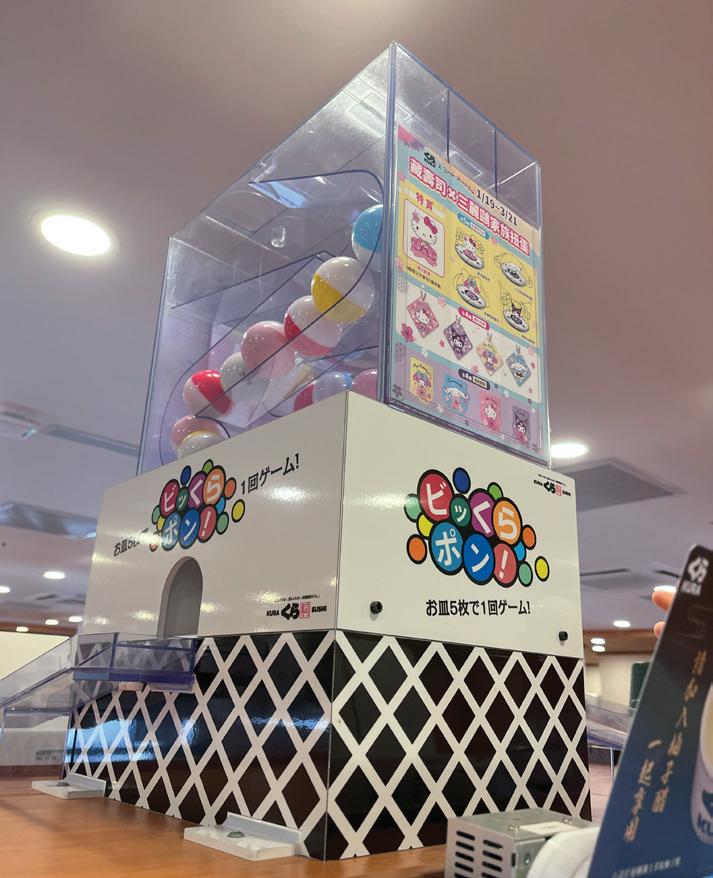
Winner: Sushiro

e fish in both restaurants taste relatively fresh, less so when you take from the conveyor belt, though.
Considering the fish stays on the conveyor belt for longer periods, it’s almost always better to order directly from the tablet.
e prices are also pretty similar between the two, with Kura Sushi’s sushi priced at 40 New Taiwan Dollars (NTD) each, with some more expensive cuts priced at 80 NTD.
Likewise, Sushiro’s options are mostly 40 NTD as well, though their more expensive options are mostly priced at 60 NTD instead of 80 NTD.
Winner: Kura Sushi

Because meals at these restaurants are designed to be convenient and efficient, cleanliness may not necessarily be a priority for workers as they switch between ushering guests in and attending to the needs of customers.
However, Kura definitely takes the win on sanitation this round. e tables were fully wiped down and sanitized before I was sat at the table. At Sushiro, on the other hand, we found soy sauce that hadn’t been wiped up on some parts of the table and patches of mysterious sticky residue on others, which extended to the tablet screens as well.
Winner: Equal

In terms of selection, both restaurants offer a variety of sushi, from classic nigiri to more unique options such as Truffle Cream Beef sushi and Fried Chicken sushi. With over 10 pages of menu items, there almost certainly is something for everyone. For those who dislike raw fish, there is a range of grilled and cooked sushi options to choose from. For those who dislike sushi in general, there are soups, fried dishes and noodle dishes. e menus of both restaurants are also often updated with new and seasonal items. However, Kura is still slightly better, considering how often they introduce new items to their menus.
P.S.: One thing to add that makes the Kura Sushi experience slightly more fun than Sushiro is the element of prizes. Stationed on top of each table is a gachapon, a vending machine-dispensed capsule toys with different prizes inside. Each time five plates are pushed into the chute, a game plays determining whether or not you win a prize. Customers are almost always guaranteed to win at least one prize during their meal. Kura Sushi even collaborates with companies such as Sanrio for events that provide newly designed prizes, making eating a plate of sushi that much more enjoyable.




When it comes to sushi conveyor belt restaurants, various aspects come into play when judging which restaurant is better, such as freshness, quality and menu options. Ultimately, though it was a close call, Kura Sushi takes the win as the better conveyor belt sushi mainly due to their cleanliness and gachapon element. However, both Kura Sushi and Sushiro restaurants serve up equally delicious food. I’d recommend both to someone craving a casual Japanese meal. Regardless of the verdict, it is a testament to the level of excellence achieved by both restaurants, allowing customers to be incredibly satisfied with a quick, on-the-go meal.




